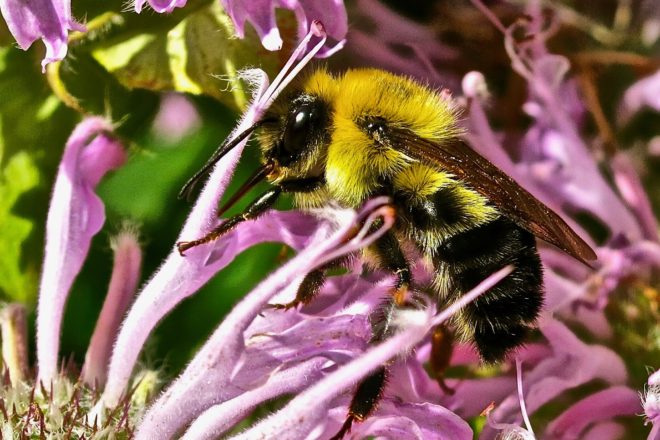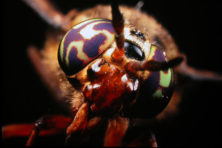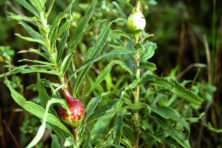Be Thankful for Insects
- Share
- Tweet
- Pin
- Share

November contains a favorite holiday – Thanksgiving. But for us kids it was more about satiation than appreciation. My mother would roast a turkey, filling the house with that tantalizing Turkey Day aroma. And then she’d make mashed potatoes, and her famous dressing, fruit salad and sweet potatoes. Dad produced the pumpkin pie. I still remember being as stuffed as the turkey had been.
Through the years Mom stressed to us kids the value of gratitude. Now, more than 60 years later, her words still ring true: “Just be thankful.” That attitude of gratitude is a priceless gift. There are countless things for which to be grateful today. An important example, ironically, is something very small that we too often fear, vilify, neglect, spray, swat, and tread upon. They are called “creepy crawly” and bothersome, and yet, this Thanksgiving, let’s be thankful for the amazing world of insects.
Many are unaware of the huge benefits of insects. For one thing, they are responsible for much of the contents of our home menu. Without them our Thanksgiving feast would be far less interesting, less nutritious, and less diverse.
Thank you, insect pollinators, for our wide array of foods ranging from almonds to apricots to apples and avocados, from bananas to blueberries, from cashews to cranberries and coffee, from grapes to grapefruit, from macadamias to melons, from peaches to pumpkins, and the list goes on and on.
But this is about way more than just our food plants. Insects are also crucial to the foods that sustain much of our native fauna. It’s been said that you don’t know what you’ve got till it’s gone. Insect populations are in serious decline. “You have total ecosystem collapse if you lose your insects,” warns Dr. Doug Tallamy, University of Delaware entomologist. “How much worse can it get than that?”
We still have an opportunity to be a positive force.

According to Dr. Tallamy, approximately 37 percent of all the animals living on the surface of this planet are plant-eating insects. Because plants defend themselves by producing toxins, plant-eating insects are selective, and have adapted to digest only certain plants.
These insect specialists, such as countless species of caterpillars, form the vital first links in a myriad of food chains. Plants use solar energy to grow. Caterpillars consume the resulting foliage and by virtue of their own bodies, make this energy (from the sun) available to animals such as birds.
The problem is, for centuries, people have been landscaping with exotic Eurasian plants. These support virtually no native caterpillars, so from the standpoint of our birds, you may as well be using plastic plants.
As if that’s not bad enough, since World War II it’s become popular to apply chemical herbicides and pesticides to maintain, mostly sterile, monoculture landscapes.
Dr. May Berenbaum uses an interesting term to describe this growing problem that’s hiding in plain sight. As an ecologist at the University of Illinois (and recipient of several awards, including the prestigious National Medal of Science), she is seeing a potential “arthro-pocalypse” as insect populations all over the world are disappearing. What we are losing are the “good guys,” countless beneficial insects: native bees, moths, butterflies, ladybugs, lovebugs, mayflies, and fireflies, to name a few.
But what can we do about it? Plenty!
The insect and the flower are one. The flower produces nectar for the insect; the insect returns the favor by insuring the next generation through the all important task of pollination. By landscaping with native plants, we are part of this mutually beneficial relationship.
Together we can help create a future for life as we know it, starting with our own yards. Here’s just one example of where rehabilitated habitat pays off.
In order to raise a clutch of six chicks, chickadees make more than 500 trips each day to gather insect larvae and spiders. In 16 days, it may require more than 9,000 feeding trips. They only forage within a 50-meter radius from the nest. This is why we need a cornucopia of native plants – think of it as a Thanksgiving banquet for birds, thanks to those incredible native plant-eating insects.
Together we can all ensure that our children and grandchildren will enjoy many Thanksgivings to come. Landscape with native trees, shrubs and flowers; Wild Ones can help.
Wild Ones has an urgent mission: “This group promotes environmentally sound landscaping practices to preserve biodiversity through the preservation, restoration and establishment of native plant communities.”
For more information visit wildones.org.
Green Bay native Dale Goodner served as chief naturalist for Peoria Park District and retired as supervisor of Environmental Interpretive Services. He and his wife Mary now live in Algoma.



